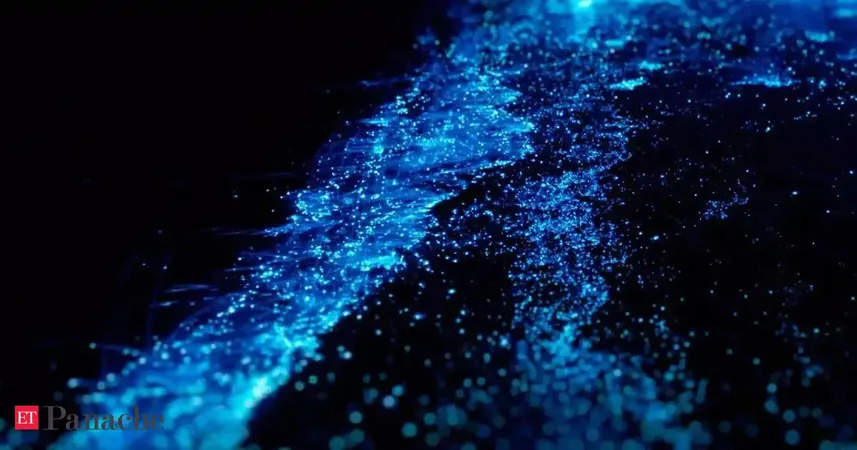
Unlocking the Mystery of 'Milky Seas': Scientists Take Aim at a 400-Year-Old Enigma
2025-04-13
Author: John Tan
A Glowing Legend Comes to Life
For over 400 years, sailors have spun tales of mystifying glowing waters, known as milky seas, that seemed to shimmer with supernatural light. Long thought to be mere folklore, a stunning new study is finally shedding light on this oceanic anomaly. Researchers are eager to predict when these enchanted waters might appear, understand their ecological significance, and investigate any potential connections to climate change.
The Mysterious Glow of the Deep
Imagine sailing on a moonlit night, only to find the sea beneath you glowing with an ethereal light, stretching endlessly. This was the experience of J. Brunskill, an officer on the SS Ixion, who described the water illuminating with a phosphorescent glow in 1967. Similarly, Captain P. W. Price aboard the MV Westmorland in 1976 was astounded by a brilliant green ocean—an otherworldly sight that blurred the lines between sea and sky.
A Groundbreaking Database
Enter Justin Hudson, a PhD student at Colorado State University, who has painstakingly compiled over 400 verified reports of these mesmerizing phenomena into a comprehensive database. Published in the journal Earth and Space Science, this breakthrough could finally allow scientists to decode the enigma of milky seas. Hudson states, "This phenomenon has existed in plain sight for centuries, yet we still don’t fully understand it. With this new database, we might finally be able to unravel what it means for oceanic ecosystems and global patterns."
More Than Just Bioluminescence
While many may associate glowing waters with the dazzling sparkle of bioluminescent plankton, milky seas are on an entirely different scale. These vast areas, sometimes exceeding 100,000 square kilometers, cast a steady glow, visible even from space. Recent studies suggest that high concentrations of Vibrio harveyi, a bioluminescent bacterium, may be responsible for this steady illumination—a revelation that still leaves many questions unanswered.
A Biological Mystery in Motion
Dr. Steven Miller, a leading researcher in milky seas, proposes that the glow could serve as a biological strategy for these bacteria. "They might be enticing fish to host them, allowing the bacteria to thrive," he explains. The ecological implications are significant, as these glowing events might alter animal behavior in the ocean's dark zones.
A Harbinger of Change?
The mysteries of milky seas extend far beyond mere aesthetics. Dr. Edith Widder, a marine biologist, views these phenomena as rare natural laboratories that could reshape our understanding of oceanic ecosystems. "What happens when animals that rely on darkness suddenly become illuminated?" she queries, highlighting the potential for revolutionary discoveries.
Climatic Connections?
Scientific curiosity also stirs questions about the broader environmental context. Are milky seas indicative of a thriving or destabilizing marine ecosystem? Hudson and Miller believe understanding these occurrences could reveal critical insights into how ecosystems are responding to climate change. "These bacterial events at the ocean's base may reveal shifting global patterns," says Miller.
Charting New Waters
Despite previous hurdles in studying milky seas, the new database opens doors to groundbreaking research opportunities. Hudson, Miller, and their team dream of witnessing this captivating phenomenon firsthand. With fresh data illuminating the way, the ocean's haunting glow might soon be understood, one wave at a time.
As these glowing mysteries continue to unfold, one thing is certain: the ocean will keep its secrets shimmering through the night.


 Brasil (PT)
Brasil (PT)
 Canada (EN)
Canada (EN)
 Chile (ES)
Chile (ES)
 Česko (CS)
Česko (CS)
 대한민국 (KO)
대한민국 (KO)
 España (ES)
España (ES)
 France (FR)
France (FR)
 Hong Kong (EN)
Hong Kong (EN)
 Italia (IT)
Italia (IT)
 日本 (JA)
日本 (JA)
 Magyarország (HU)
Magyarország (HU)
 Norge (NO)
Norge (NO)
 Polska (PL)
Polska (PL)
 Schweiz (DE)
Schweiz (DE)
 Singapore (EN)
Singapore (EN)
 Sverige (SV)
Sverige (SV)
 Suomi (FI)
Suomi (FI)
 Türkiye (TR)
Türkiye (TR)
 الإمارات العربية المتحدة (AR)
الإمارات العربية المتحدة (AR)